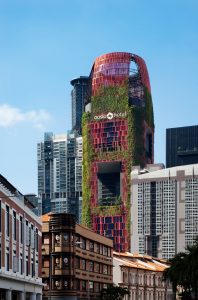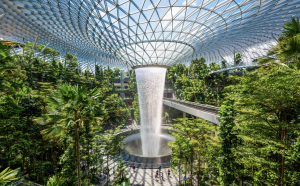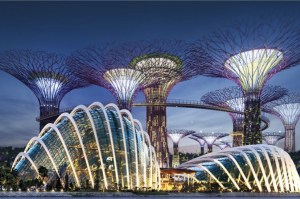The UNESCO Creative Cities Network (UCCN), established in 2004, aims to foster cooperation among cities that recognize creativity as a key driver for sustainable urban development. In 2015, Singapore joined this network as a City of Design. As a result, Singapore has paved their way to being one of the most design oriented cities in the world. Then it brings up a question: How can Singapore become an influential example in the world through environmental and societal advances?
Democratized approach to designers
 Campaign led by DesignSingapore Council
Campaign led by DesignSingapore Council
Whether it is the appreciation of well-designed solutions, or the spaces Singaporeans live in, design can be seen to elevate daily life of the locals. As a result, Singapore has taken the approach of introducing design as part of different professions and encouraging professionals to take a broader perspective when making decisions in their work. DesignSingapore Council has launched a campaign called “People of Design” that credits people that focus on designing a better society and environment. Oh Chu Xian is one of the prime examples of Singaporeans who has introduced design to a completely unique field- construction. Throughout her journey, Oh has leveraged creative thinking to challenge conventions and transform post-plastic material innovation into a sustainable business model. Reflecting on her experience, she says, “I’ve had to be creative almost every single day of being a startup founder because everything is new.” Beyond this, she has realized the importance of reimagining established processes, even collaborating with her partners to design plastic waste recovery systems.
As seen from this example, enabling people to tap into design theory, methods or simply the creativity of it can have a big impact on the surroundings. What if business leaders, innovators and other professionals opened up to the idea of learning more about design? Could that be the catalyst for global change and innovation on multiple levels?
Designing for architecture
Singapore has established itself as a global leader in incorporating sustainable architecture into its urban landscape, achieving significant reductions in environmental impact while improving the quality of life and satisfaction for its residents.
Since the 1960s, Singapore has pursued the vision of becoming a “Garden City,” championed by its founder, Lee Kuan Yew. This initiative has led to extensive urban greening projects across the city-state that integrate nature into the city’s dense urban environment. As a result, green cover has increased significantly, now encompassing around 50% of the city-state. Central to these greening efforts is the concept of biophilic design, which seeks to enhance Singaporeans’ connection to the natural environment through architecture and the design efforts.
A prime example of this approach is Jewel Changi Airport, a pioneering structure that features the world’s tallest indoor waterfall and lush gardens within an airport mall. This centerpiece of Singapore’s world-class airport alleviates traveler and shopper fatigue with its innovative design. Despite being open for just two years, Jewel Changi Airport has become a major tourist attraction, redefining the traditional definition of an airport and establishing itself as a must-see destination.
Gardens by the Bay is a prime example of biophilia, featuring a futuristic nature park adorned with “supertrees”—steel-framed structures reaching up to 50 meters high, covered with over 150,000 real plants. Since its opening in 2012, the park has become a major attraction for both domestic and international visitors, as well as an important platform for biodiversity conservation.
Another captivating building in Singapore is the Oasia Hotel Downtown by WOHA. The entire 27-floor exterior facade of Oasia Hotel Downtown is enveloped in a vine-covered natural sunscreen, offering shade and reducing the need for air conditioning which is a known energy consumer. The hotel also boasts of sky terraces, nearly 2000 large-scale planter boxes, and 4 structural cores that help to ensure excellent cross ventilation. This significantly contributes to lowering overall energy costs and consumption. Oasia Hotel Downtown seamlessly incorporates green architecture into its design by featuring over 30 different plant species and more than 20 types of climber plants and vines.
 Oasia Hotel Downtown in Singapore
Oasia Hotel Downtown in Singapore
The ongoing dedication to a “green and clean” Singapore is largely sustained by the strong morale and discipline of its citizens. As Singapore continues to evolve, it will undoubtedly innovate in reimagining structures and spaces, placing nature at the core of its construction efforts and truly living up to its “garden city” title.
Scholarships that inspire
In order to support the consistent innovation through design, for a small city-state like Singapore, the government offers different scholarships. It is less common in the Western World to support a specific industry and its professional development but it is more the efforts and success that get the attention. Singapore and DesignSingapore Council have taken a new approach by offering design specific scholarships to make sure to continue the environment and future oriented approach.
 DesignSingapore Council Scholarship
DesignSingapore Council Scholarship
Those scholarships nurture the next generation of talent, allowing it to contribute to the design industry in any Singapore based company. This initiative opens up pathways to rewarding careers and opportunities to contribute to the advancement of the nation’s design industry. Since its establishment in 2005, the annually awarded scholarship has supported around 70 scholars who have become design leaders, driving the industry towards new horizons. These scholars have significantly impacted Singapore and the design profession by transforming organizations to be future-ready, fostering cross-disciplinary collaboration to spur innovation, and enhancing the curiosity for creativity in the next generation.
It is evident that the initiatives and creativity present in Singapore have changed the way the locals live and have set an example for the planet. It’s not only the government that tries to make a change but also the Singaporeans have a firm belief in a greener future. Furthermore, the changes initiated by the government enable the less design-oriented professionals to tap into the creativity and reflect on glocal design.
Sources
Singapore greening and biophilic design
Sustainability in Singapore architecture






